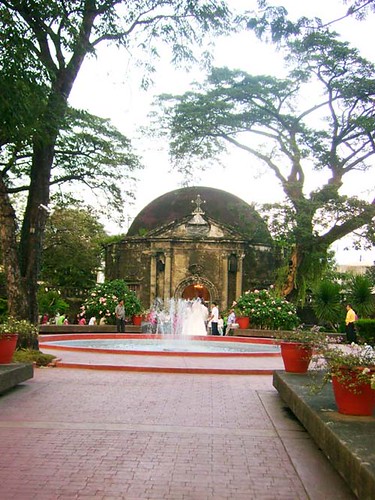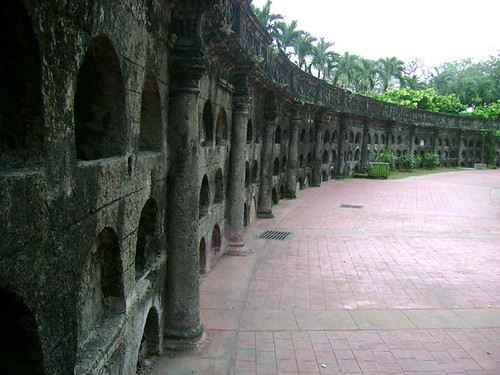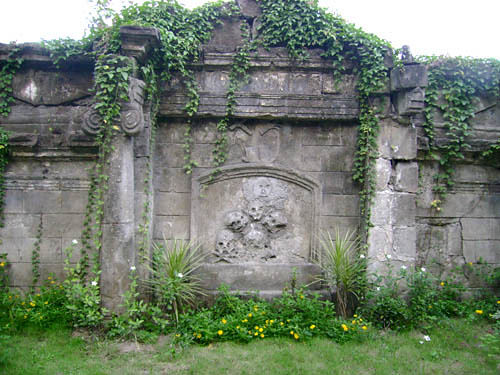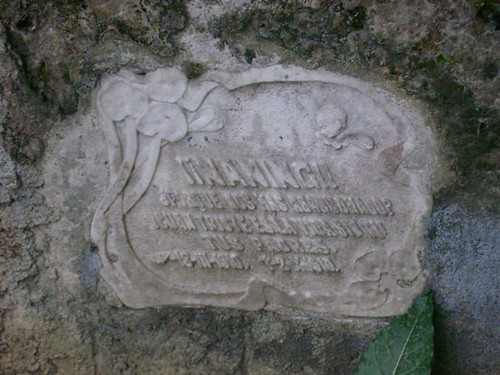I was curious to find out what Paco Cemetery looks like these days, so I went for short break and visited the serene parque in the heart of Paco. This old burial ground has been transformed into a park for the quiet strolls and is now a preferred location for romantic weddings. This cemetery perhaps is one of the greatest marvels of Spanish engineering and design that still endures today, together with Intramuros, the plazas and the forgotten houses of Spanish colonial Manila.

San Fernando De Dilao's old cemetery
The charge for the entrance is five pesos, yes, that's a steal, everyone can afford it even with our so called economic troubles. The first thing that would greet you are armed security guards [they have these rusty revolvers tucked inside their black leather holsters, they told me that they guard the place against vandals], this I said is a good sign, at least someone's watching over the place.
Memories of Paco
The first time I went to Paco Park was when I was in secondary school, around '95, and back then there were many headstones left, the lawn were well tended, the floras were blossoming, it was healthier then, the trees shelters hi guests from the heat of the sun, the park was breathing, it was still appealing.
[

The Burial Walls
Today, almost all the lapidas are gone, leaving some graves exposed, while some had been enclosed by cement. The families had already transferred the remains some place, I never really found out why, were they ordered to do so by the Imelda during its transformation?
I heard that some of untaken remains were buried in a common grave, I hope its not true. The headstones should've been brought back to the walls [just like what the Singaporean did in Canning], a custodian there said that they had been lost when the graves were opened. Some of these works of art can still be found in pieces resting on the ground, they were made of the finest marble, the craftsmanship on the embedded letters is exceptional.
Short history of the cemetery that was Paco

Burial place dedicated to infant
"in 1807 an administrative order was issued for the construction of a cemetery in Bagumbayan in the town of San fernando De Dilao, commonly known as Paco, near the town of Ermita. Maestro de Obras, Don Nicolas Ruiz prepared the plan, the order was an off shoot of a Cholera epidemic which ravaged Manila in the late 18th century.
the original cemetery was finished on April 22, 1822 although at that time it had already been used for two years. Construction was supervised by a certain Don Jose Coll.
In 1859 then Gov. Fernando de Norzagaray proposed enlarging the cemetery to 4540 varas cuadradas, approximately 4500 square yard, to be enclosed by a circular wall. A Chino Mestizo builder won the contract to build the outer portion of this cemetery for 19,700 pesos. the cemetery used to have a Chaplains and eight caretakers, The Chaplains use to reside across the cemetery on site presently occupied by the Paco Fire Station.
The niches cost 20 pesos for 3 years subject to renewals. No one was allowed to won the niches in perpetuity."
*Governor General Ramon Solano Y Lladeral is interned inside the chapel.
Lapidas, Faith & Espanol!

An emotional epitaph from the parents of the dead child, "NANING! porque nos has abandonado, cuan triste es la vida sin tu", the parents asking their child why he left them and how sad their lives had become without him."
Back in the older days, what I notice was that all the lapidas were not only arty but had its dedication in pure Spanish, I found it unusual, weren't we "deprived" of learning this language, is it not what we have been taught in school? I did ask my history teacher then [Mrs. Arevalo?], I remember she said something about Catholicism, that there was a connection. Of course there is!
The lapidas in Paco is a demonstration of not only our abiding commitment in the religion that was brought to our shores by the Spaniards, but it also points to the old Filipinos preference for the Spanish as their lengua oficial. Up until the upheaval of 1896, it would be accurate to state that it was the language of the revolution. When you examine the old administrative papers in the archives, you'll instantly noticed that there were no translations to Tagalog or any local language, its either you comprehend what it says, or have someone interpret the words for you, that is how it works - under those conditions even the Filipino Chinese learned Spanish, it was never formally introduced in lower schools [but it has always been part of our higher curricula] until the introduction of the Spanish public school system, yes, but the Filipino's adapted, they had no choice. Spanish was widespread than what is admitted in our English history books which puts the inhabitants communicating in Spanish at a measly 1%[Palanca and Ford had already made a conclusive reports that Spanish is prevalent even among the provincials], but since English was made obligatory by the era of the Yankees, they made it appear that very few, hardly any speaks Castillian, and that it is only right to commence teaching English, this dim justification motivated them to tutor their lil' brown brothers in English. It was here that we slowly drifted away from our Hispanic past.
Now that the lapidas are gradually diminishing, we'll never see how the Filipino of the Spanish period dedicate memorials for their dearly loved friends and relatives. This folks could've been familiar with the lines attributed to Charlemagne, "Spanish is the language with which to speak to God", because otherwise they would've used something else.
The current (mis)administration of Paco
The Paco cemetery of today has been neglected, thanks to the sub agency of the department of tourism for allowing dumb administrators to run the place. When I visited the park, there were shanties inside, yes, tent like dwelling. I requested to speak to whoever was in charge, since I had my bulky camera with me I pretended to be a reporter - he must've bought right into it and even offered me a tour! he said, "Sir, mga tao ko yan, sila ang naglilinis dito saka tumutulong sa pagbabantay sa gabi!", at this point I was contemplating of smashing my camera on his head! what is going on man! what will be your next project, build a mercado inside? or expand your shelter project?
Mr. Peter, I must admit is mild mannered guy, he even divulged to me that they'll be securing around 5 million pesos for rehabilitation, I told him, "I hope you wouldn't tear down the originals", he had this puzzled look on his face, probably asking himself, what would be the use of the 5 million if I can't used it cementing the crumbling adobe walls or maybe painting over it?
Obviously, he haven't encountered the word "restoration" just yet. But I know that any changes would have to get an endorsement from NHI, of which Ambeth Ocampo is chair, so there's hope.
Save our Paco cemetery oh youthful St. Pancratius!



thanks for sharing this...
ReplyDeleteHispanic trails are hard to trace and will be harder for the coming days for Filipinos of today is geared to change the way it looks and prefer to turn it into "Bongacious" western styles.
We have to comprehend the essence of this saying:
"Ang hindi marunong lumingon sa pinanggalingan ay hind makakarating sa patutunguhan."
Maybe one of the reason why the road to success for Pinoys remains long and hard....
Juliet
Its time to look at our history without the 'propaganda' mind set, as I call it. The Spaniards are no longer here and frankly, I really don't care about them, they're no different from other foreign countries of which we share friendly ties these days.
ReplyDeleteIn a generation that has been taught to hate its 400 years of culture and history, but curiously, a people that find beauty in naming their children with the most unique of American names and of priding oneself with having American connections, says something about what we have become as Filipinos.
The fact that Filipinos of today doesn't have a clear understanding of what it means to be one is sad.
oh how nice. Thanks for the online tour. :-D
ReplyDeleteSir, correct me if I am wrong but…were the remains of GOMBURZA lost in Paco Cemetery?
ReplyDeleteThey were buried in Paco...
ReplyDeleteWhere are their remains? hold on to your seat, Francis.
The burial site of the GOMBURZA is actually the area where the idiotic administrators [parks and wildlife under DOT] during the 90's built the toilet. This was confirmed by no other than the NCC director, I think it was in the late 90's. Anyway, they built the marker close to the toilet, missing the spot for about 15-20 feet.
Hey Nold! Paco is special to me. I got married there last year. I like old historical churches (and chapels for that matter).
ReplyDeleteLast December I revisited San Agustin. Would you know happen to know why they colored the church facade peach?
Yes, I know I read it from your post, I found out that you did all the arranging for the event, that's fantastic - congratulations again Joe and to the Wifey! and BTW that lovely chapel in Paco is an excellent choice.
ReplyDeleteYeah, I don't know what exactly happened, It was strange maybe because were just used to what it use to look like, I'm trying to contact Fr Galende, that generous and amiable Augustinian to find out what's with the changes.